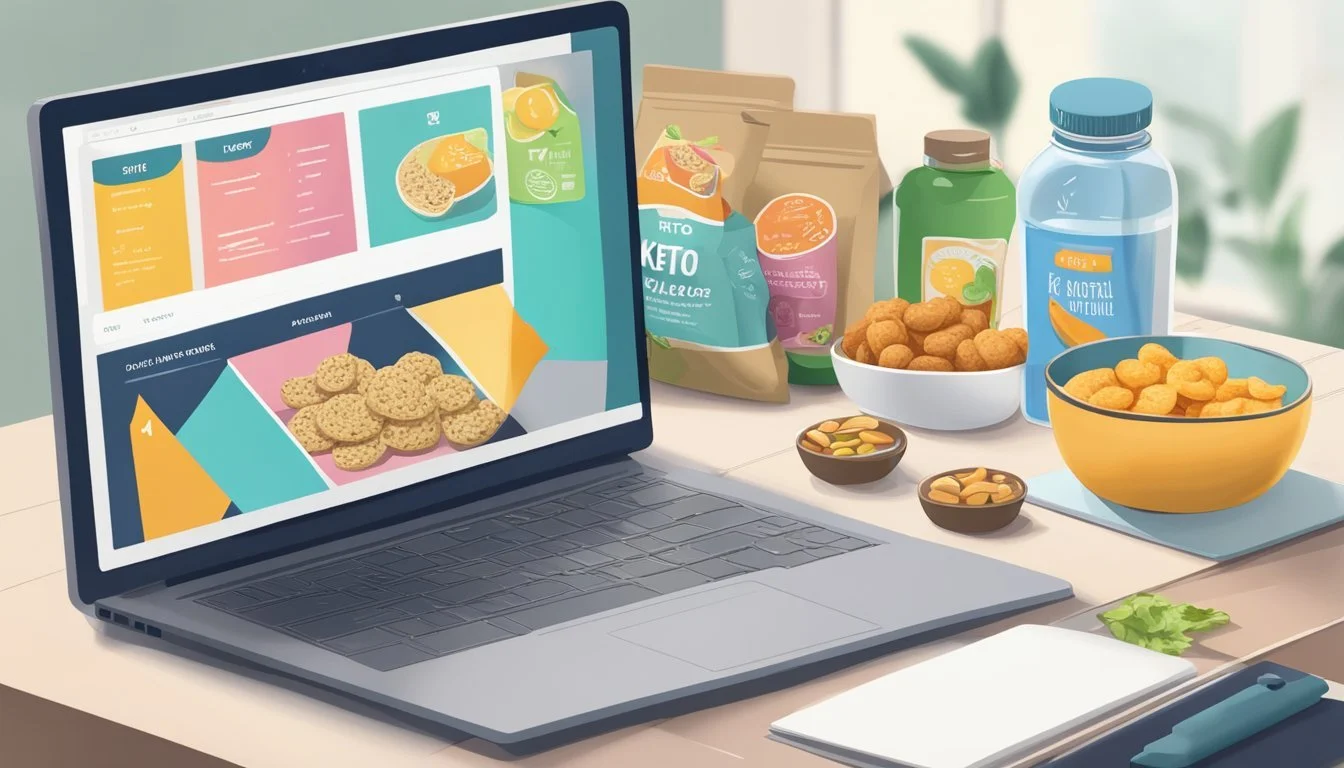Keto Diet for College Students
Balancing Health and Studies
Adopting a ketogenic diet, commonly known as a keto diet, is becoming an increasingly popular choice among college students looking to enhance their health, manage weight, and improve both energy levels and focus. A keto diet is characterized by its low-carbohydrate, high-fat nutritional regimen, which aims to induce a metabolic state known as ketosis. During ketosis, the body is trained to burn fat for fuel instead of relying on carbohydrates, which can lead to weight loss and potentially provide a more consistent energy supply.
For college students, maintaining this diet on campus presents unique challenges, including navigating dining hall options and sticking to a budget. Yet, it's feasible to maintain a ketogenic lifestyle amidst a hectic academic schedule. The key lies in recognizing keto-friendly foods such as scrambled eggs, cheese, grilled chicken breast, and a variety of deli meats (how long do deli meats last?), which are commonly available in college dining facilities.
While the ketogenic diet is not a one-size-fits-all solution, its potential benefits in weight management and metabolic health have been recognized in numerous studies. However, it's essential for students to tailor the diet to their individual needs, taking into consideration their daily activities and nutritional requirements. By leveraging available resources and making informed food choices, college students can effectively balance a keto diet with their academic commitments.
Understanding Keto
The ketogenic diet, commonly called "keto," prompts the body to enter a state of ketosis, where it burns fat for fuel instead of carbohydrates. This section will examine ketosis and ketones, the diet's benefits, and potential risks and side effects.
Ketosis and Ketones
Ketosis is a metabolic state wherein the body efficiently burns fat for energy and produces ketones. When carbohydrate intake is significantly reduced to typically between 20 to 50 grams per day, the liver converts fat into fatty acids and ketone bodies. These ketone bodies serve as an alternative energy source for the brain and other organs when glucose is scarce. Ketones can be measured in the blood, and their presence indicates that the body is in ketosis.
Benefits of a Ketogenic Diet
The ketogenic diet has several potential benefits:
Weight Loss: By relying on fat for energy, the body may lose weight more effectively compared to high-carbohydrate diets.
Blood Sugar Levels: Lower intake of carbs can lead to a reduction in blood sugar spikes, which is particularly beneficial for individuals with diabetes.
Blood Pressure: Some studies suggest that a ketogenic diet can help lower blood pressure, which may reduce the risk of heart complications.
Mental Clarity: Many adherents report increased mental clarity and focus due to stable blood sugar levels.
Potential Risks and Side Effects
While beneficial for some, the ketogenic diet can pose risks:
Keto Flu: A temporary group of symptoms experienced by some individuals when first entering ketosis, including headache and fatigue.
Kidney Stones: There is an increased risk of kidney stones due to higher excretion of minerals and possible dehydration.
Nutrient Deficiencies: Restrictive nature of the diet may lead to deficiencies in essential vitamins and minerals without careful planning.
Long-term Effects: There is limited research on the long-term effects of a ketogenic diet. It is important to consult a healthcare provider before starting the diet.
Building Your Keto Menu
Crafting a ketogenic diet menu requires understanding both the types of foods that fit into a keto lifestyle and how they contribute to the necessary balance of nutrients. This section will focus on assembling a menu that adheres to keto principles while ensuring nutritional needs are met.
Macronutrients and Micronutrients
Understanding macronutrients (macros) is crucial to maintaining ketosis. A typical ketogenic diet emphasizes:
High fat intake, usually 70-80% of total calories.
Moderate protein, accounting for about 20-25%.
Very low carbohydrates, often between 20-50 grams per day.
These macros help the body shift from using carbohydrates to fats as its primary energy source. Consuming adequate fibers, vitamins, and minerals is key to preventing deficiencies and supporting overall health.
Keto-Friendly Foods and Alternatives
Keto menus revolve around foods that are high in fat and low in carbs. Some examples include:
Meat: Beef, pork, poultry, and fish are excellent protein sources.
Vegetables: Leafy greens, broccoli, cauliflower, zucchini, and bell peppers are low in carbs and rich in nutrients.
Cheese: Hard and soft cheeses provide both fat and protein.
Nuts: Almonds, walnuts, and macadamia nuts are high in fats and low in net carbs.
Keto-safe sweeteners: Stevia, erythritol, and monk fruit can be used in moderation to satisfy sweet cravings.
Substituting high-carb items with these keto-friendly alternatives can help maintain a balanced diet and contribute to a successful keto plan.
Dealing with Cravings and Hunger
When transitioning to a ketogenic diet, individuals may experience cravings and hunger. Here are strategies to handle these challenges:
Plan meals: Having keto-approved foods readily available can deter one from reaching for high-carb snacks.
Eliminate temptation: Remove non-keto foods from one’s living space to avoid giving in to cravings.
Stay hydrated: Sometimes thirst is mistaken for hunger. It’s important to drink water throughout the day.
Include fiber: High-fiber keto foods help one feel full longer and can minimize hunger pangs.
Practical Tips for College Students
Embarking on a keto diet in college needn't be a drain on finances or an insurmountable challenge given the limitations of dorm life and dining options. This section provides definitive strategies to maintain a ketogenic lifestyle that suits a student's budget and facilities constraints.
Eating Keto on a Budget
For college students on a budget, being ketogenic-friendly means smart grocery choices. Protein-rich foods such as hardboiled eggs and canned tuna provide affordable options that are both filling and in line with keto guidelines. Cheese sticks are another budget-friendly and convenient snack that students can easily store in dorm room refrigerators. Ground beef or patties for bun-less burgers can be purchased inexpensively, especially when buying in bulk, and they freeze well for long-term use.
Key Budget Foods:
Eggs: Hardboiled for ease.
Tuna: Ready-to-eat cans.
Cheese sticks: Good for grab-and-go snacking.
Ground beef: Bulk buy and freeze for future use.
Dorm-Friendly Keto Snacking
Snacking is often a college student's antidote to late-night studies, and keto snacking can be both satisfying and healthful. Nuts and seeds epitomize the perfect keto snack, as they are filled with healthy fats and are very portable. Students should also consider stocking up on keto-friendly foods like olives, cheese sticks, or avocado, which require minimal preparation. To resist the temptation of high-carb convenience foods, students can prepare snacks in advance and have them readily available.
Recommended Snacks:
Nuts and seeds: Almonds, macadamias, and chia seeds.
Olives: Packed with healthy fats.
Avocado: Rich in potassium and fiber.
Maintaining Keto while Dining Out
Eating out doesn’t have to derail a student's keto efforts. When reviewing a restaurant menu, students should focus on dishes that highlight meats and vegetables while steering clear of carb-laden sides. Opt for a lettuce wrap instead of a traditional bun with burgers and sandwiches, or request a side salad in lieu of fries. Always choose dressings and sauces that are low in sugar and carbohydrates, and don’t hesitate to ask for modifications to fit keto needs.
Dining Out Tips:
Burgers and Sandwiches: Ask for a lettuce wrap.
Sides: Substitute fries with a side salad.
Dressings and Sauces: Opt for those low in sugar, like ranch or blue cheese.
Meal Planning and Preparation
Successful keto dieting in college revolves around strategic meal planning and preparation that fits in with a student's busy schedule. Students should focus on incorporating high-fat, low-carbohydrate foods that align with their nutritional objectives.
Keto Meal Ideas for Breakfast, Lunch, and Dinner
Breakfast: A student can start their day with scrambled eggs mixed with cheese and spinach. Another option could be a breakfast sandwich with bacon or sausage; simply discard the bun to keep it keto-friendly.
Lunch: Tuna salad made with full-fat mayonnaise served on a bed of greens offers a satisfying midday meal. Alternatively, deli meats wrapped around cheese sticks provide a quick, portable lunch.
Dinner: For an evening meal, students can opt for a grilled chicken breast or a burger patty topped with avocado (how long does avocado last?). Always exclude the bun and add a side of low-carb vegetables like broccoli or cauliflower.
Preparing Meals in Advance
Meal preparation is key to maintaining a keto diet amidst a busy college schedule.
Batch Cooking: Students can cook proteins like chicken or beef in large quantities and refrigerate for use throughout the week.
Egg Muffins: Preparing egg muffins with vegetables and cheese is an efficient way to have a grab-and-go breakfast or snack.
Navigating Social Situations and Events
Navigating social events requires planning ahead to ensure dietary goals are met.
Dining Halls: When eating in the dining hall, students should look for salad bars to create their own keto-friendly salad, topping it with hard-boiled eggs, cheese, and olive oil.
Social Events: Before attending events or parties, eating a keto-friendly meal can help one avoid temptation. If food choices at the event are limited, aiming for cheese platters and avoiding high-carb options is a safe strategy.
Lifestyle Considerations
Adopting a ketogenic lifestyle in college requires strategic planning to align with exercise regimens, academic responsibilities, and potentially even intermittent fasting schedules to maintain energy, focus, and overall wellness while managing expenses like student loans.
Incorporating Exercise with Keto
On a ketogenic diet, students may notice a change in their energy levels, which can impact their exercise routines. It's essential they listen to their body and adjust the intensity of workouts accordingly. Initially, as the body adapts to burning fat for fuel, there might be a temporary decrease in stamina. However, as they become keto-adapted, many report sustained energy that can support an exercise regimen. Students should aim for a mix of cardio and strength training exercises to complement the diet's benefits.
Balancing Keto with Academic Responsibilities
Nutritional ketosis has been associated with heightened focus and cognitive clarity, an asset for any college student juggling academic responsibilities. To maintain this mental sharpness, students should ensure their keto meal planning doesn't interfere with study schedules. Preparing keto-friendly meals in advance and having low-carb snacks on hand can save time and help avoid the temptation of non-compliant convenience foods. Students must be mindful of their budget, bearing in mind that a well-planned keto diet can be compatible with the constraints of student loans.
Combining Keto with Intermittent Fasting
Intermittent fasting (IF) can be a powerful complement to the ketogenic diet, potentially enhancing its effects on body composition and metabolic health. When a student chooses to combine IF with their keto lifestyle, it's important to time eating windows to support both their energy needs and academic schedule. For instance, they might schedule their eating period to precede study sessions or classes where optimal cognitive function is needed. This synergy can promote wellness while accommodating a student's limited resources and tight schedule.
Supplements and Hydration
A ketogenic diet for college students must address the increased need for specific supplements and adequate hydration to maintain optimal health and replace what may be lost during ketosis.
Essential Supplements to Consider
Students on a ketogenic diet often need to supplement their intake with key nutrients.
Electrolytes: A critical trio of sodium, potassium, and magnesium helps prevent the "keto flu" and supports muscle and nerve function. One may find them in:
Sodium: Table salt or broth
Potassium: Avocado, spinach, or supplements
Magnesium: Almonds, chia seeds, or supplements
Vitamins: Vitamins A and C are important for immune function and skin health. They are not stored in large amounts in the body and should be replenished regularly. Sources include:
Vitamin A: Eggs, cheese
Vitamin C: Leafy greens, zucchini
Fiber: Essential for digestive health, fiber must be obtained through low-carb sources, such as:
Chia seeds
Flax seeds
Vegetables like broccoli and cauliflower
Staying Hydrated on Keto
Hydration is paramount on a ketogenic diet, and students should strive to consume ample fluids throughout the day.
Water: The cornerstone of hydration. Students should drink at least 8 glasses (64 ounces) daily, and more if they are active or live in hot climates.
Hydration Boosters: To further enhance hydration, consider adding:
A pinch of salt to water, to replenish sodium
Lemon juice or apple cider vinegar for flavor and potential digestive benefits
Regular monitoring of hydration status is crucial, and students should look for signs of dehydration such as fatigue, headaches, or dark urine. Supplements and hydration together form a solid foundation for a healthy keto lifestyle in college.
Overcoming Challenges
Adopting the keto diet during college can present unique challenges. Students must navigate misconceptions, manage the keto flu, and find supportive communities for a successful transition to and maintenance of a ketogenic lifestyle.
Common Keto Misconceptions
Misconception 1: All fats are good on keto. Not all fats are created equal. Students should focus on healthy fats like avocados, nuts, and olive oil for optimal health.
Misconception 2: Keto is high-protein. Keto emphasizes fat intake and moderate protein, contrary to the belief that one should consume high amounts of protein.
Misconception 3: Keto allows zero carbs. While low in carbohydrates, the keto diet does include small amounts of nutrient-dense carbs, such as leafy greens.
Dealing with Keto Flu
When beginning keto, some students may experience the "keto flu," a collection of symptoms akin to the flu. This typically occurs as the body transitions from burning glucose to fat for energy. Symptoms may include:
Fatigue
Headache
Irritability
Difficulty focusing (or "brain fog")
Lack of motivation
Dizziness
Sugar cravings
To alleviate keto flu, students can:
Increase salt intake to combat electrolyte imbalances.
Stay hydrated by drinking plenty of water.
Consume bone broth or bouillon, rich in sodium and minerals.
Get adequate sleep to help the body adjust.
If symptoms persist, students should consult a registered dietitian knowledgeable about keto adaptations, especially if they are overweight and the diet is part of a weight management regimen.
Finding Support and Community
Developing a strong support system can significantly influence one’s success on the keto diet. Students should seek out fellow keto dieters by:
Joining keto-focused social media groups or local clubs.
Attending keto-friendly events or potlucks to exchange experiences and recipes.
Partnering with a dietitian or healthcare provider who can provide professional guidance and support.
Collegiate community resources, such as health and wellness centers, may also offer connections to other individuals on the keto diet, which can be vital in maintaining motivation and gaining insights into effective ketogenic living.
Beyond the Diet
In addressing a ketogenic lifestyle, students must consider both the sustainability of their dietary choices and the long-term health outcomes. A ketogenic diet should transcend mere short-term goals and evolve into a sustainable, health-focused way of life.
Sustainable Keto Living
Sustainable keto living for a college student hinges on selecting high-quality, whole foods that are rich in nutrients. They should prioritize healthy fats such as avocados, olive oil, and nuts, while incorporating a variety of low-carb vegetables like spinach, kale, and broccoli.
Healthy Fats:
Avocado
Olive oil
Nuts and seeds
Low-carb Vegetables:
Spinach
Kale
Broccoli
By embracing these food groups, students can create a balanced and sustainable approach to keto eating that fits their lifestyle.
Long-Term Health Outcomes
Keto diets, when well-formulated and nutrient-dense, may contribute to favorable long-term health outcomes. They should ensure a consistent intake of a wide array of nutrients to support their overall health.
Whole Foods: Aim for unprocessed meat, dairy, and eggs.
Nutrient Intake: Focus on foods high in fiber, vitamins, and minerals to maintain health and energy levels.
Students must be mindful of their body's responses and consult healthcare professionals to tailor their diet for optimal long-term health while adhering to a ketogenic lifestyle.








